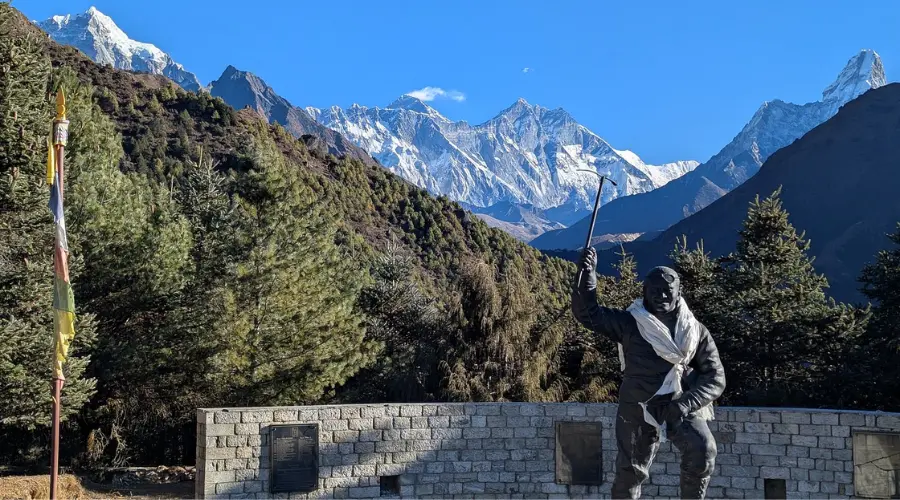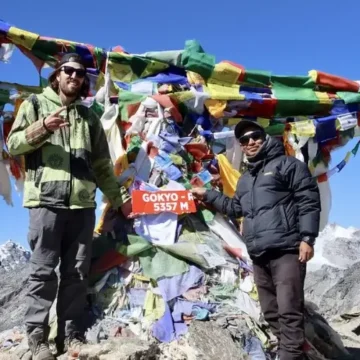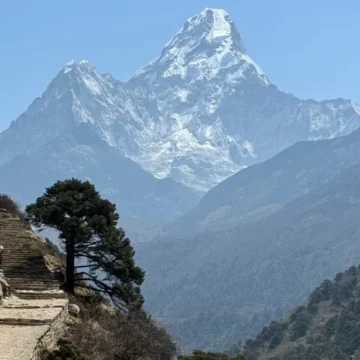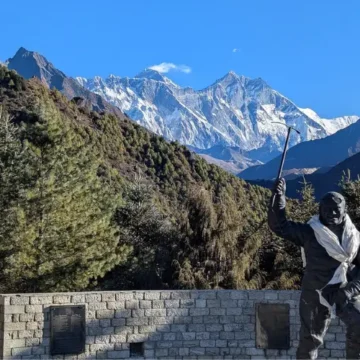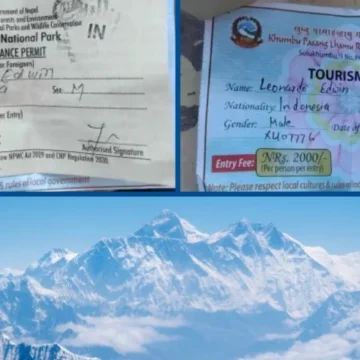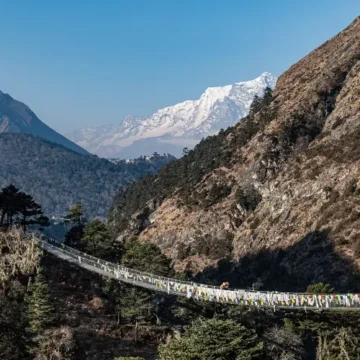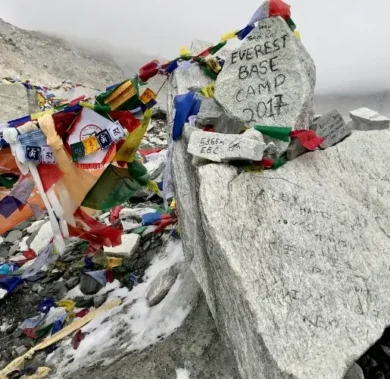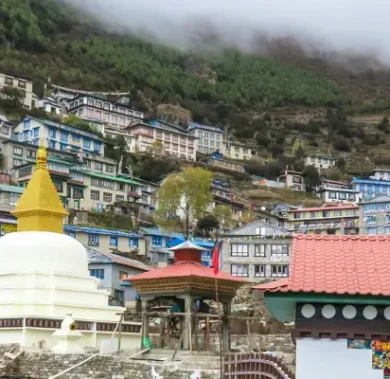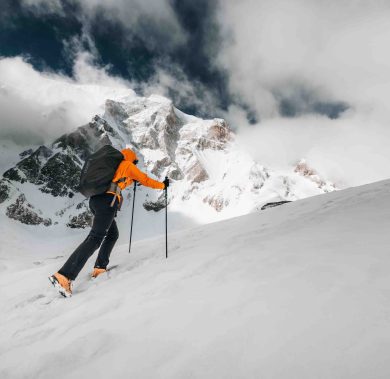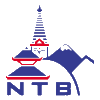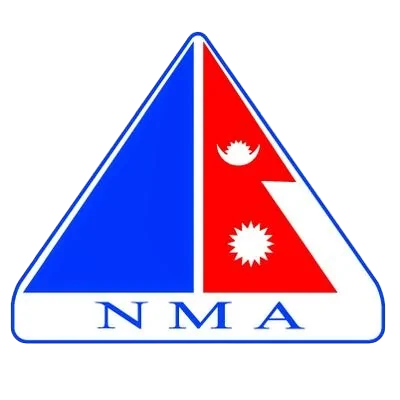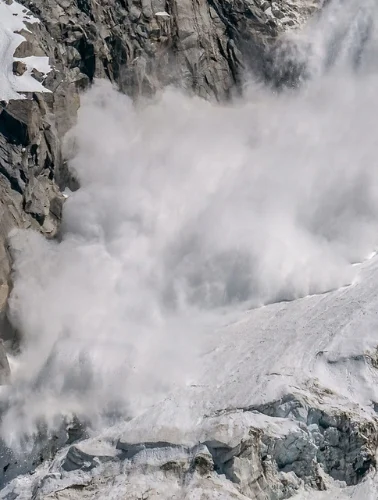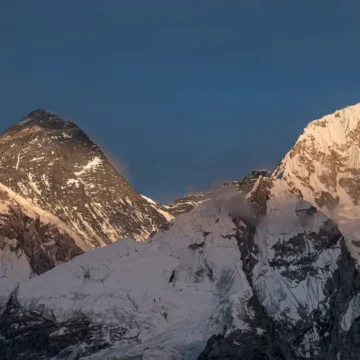
Everest Base Camp Trek Insurance, Safety and Emergencies
Table of Contents
Everest Base Camp Trek Insurance isn’t just a formality; it’s your financial and medical backup in one of the world’s most remote, high-altitude regions.
Trekking to Everest Base Camp might be the most thrilling and culturally rich adventure in the Himalayas. However, it comes with risks such as altitude sickness, unpredictable weather, delayed flights, and sometimes even requiring emergency helicopter evacuations.
Trekking up to 5364 meters (17,599 ft) at Everest Base Camp (EBC) and Kala Patthar (5550 m/18,209 ft), you are at constant risk. Under such conditions, Everest Base Camp Trek insurance is not just some paper but absolutely essential.
Trekking without proper insurance, an injury or illness could quickly become life-threatening or financially devastating. So, we suggest that you get good high-altitude trekking insurance before setting out for the Himalayan adventure.
Make sure to choose the best and cheapest providers, and go through all the terms and policies before signing the contract.
Why is Insurance Essential for Everest Base Camp Trek?
Trekking in the Everest region means venturing into the unknown. Travelling into some of the most untouched, pristine landscapes and high-altitude villages where the road access and medical facilities are limited.
High Altitude
The most challenging part of the Everest trek is the altitude. As you ascend higher, your body feels exhausted due to a lack of breathable oxygen. Particularly above 2500 meters (8000 ft), your body can experience difficulty in breathing, nausea, headache, etc., and signs of altitude sickness.
This can lead to exhaustion both physically and mentally. If the case worsens, you might need a helicopter evacuation. So, it is always advised to get insurance whenever you plan to trek in high altitudes.
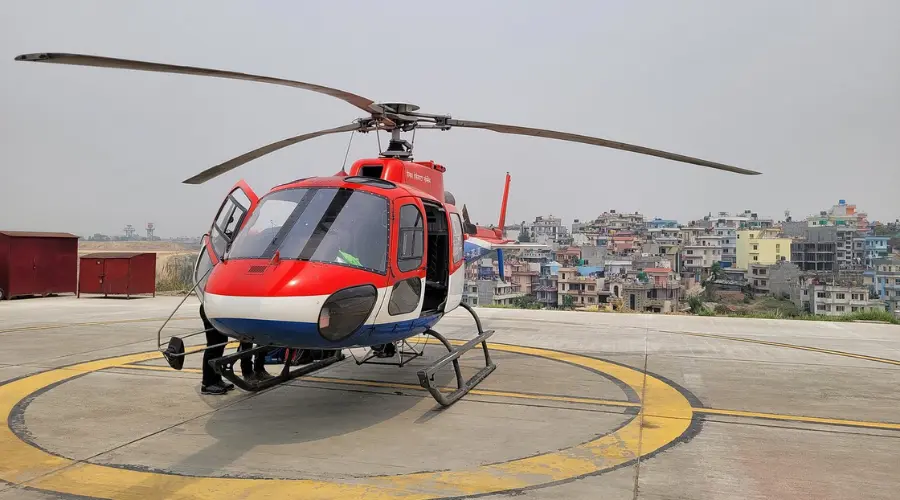
Unpredictable Weather
In the Himalayas, the weather can change at any time. A beautiful, calming morning can transform into a windy, foggy afternoon, and a cloudy noon can give way to a clear, blue-sky evening, offering some of the best views of Everest and the rest of the Mahalangur mountain range.
Sometimes, nature’s blizzards, like snowstorms, chilling high winds, or heavy rain, can halt or cancel your trek. For that reason, it is essential that your Everest Base Camp Trek insurance has trip cancellation coverage.
Accidents and Common Injuries
In this remote location, accidents can occur anytime, anywhere. The path is uneven and rocky, and can get slippery with rain and snow. So, it is common to get injured by falling stones or twisting your ankle. So, be careful whenever you are in the mountains.
Additionally, other common problems that you can face are food poisoning, diarrhea, or gastrointestinal issues. Though these issues are generally not so harmful, when you are days away from a proper medical facility, they can become serious.
These minor incidents may require you to end the trek and still require medical attention. Your Everest Base Camp Trek Insurance should cover these more common medical scenarios, not just the dramatic, high-altitude emergencies.
Remoteness and Lack of Advanced Medical Facilities
As you trek higher, the Everest region becomes more remote, especially around the Everest Three Passes Trek route, where medical supplies are limited. There aren’t even many teahouses or visitors compared to the standard route.
Though basic medical facilities are available at Namche Bazaar and Lukla. In case of emergency, you will need to be evacuated to Kathmandu or another nearby city where modern medical facilities are available.
High Cost of Emergency Evacuation
In case of a serious medical emergency, the only way out of the Khumbu region is by helicopter evacuation. There is no road access, so carrying trekkers down could take days.
So, whether from severe altitude sickness or a bad fall, helicopter evacuation is quite expensive.
A helicopter evacuation can cost up to $5000-$6000, depending on your location, the weather, and the number of flights required.
The cost must be paid upfront or guaranteed by a reliable insurer. Paying such a huge sum without insurance can be backbreaking for many. This financial risk alone makes the trek unthinkable without proper coverage.
What Should Everest Base Camp Trek Insurance Cover?
Not all insurance plans cover high-altitude trekking and emergency helicopter evacuation. Lots of standard travel insurance plans exclude these on purpose. So, it’s necessary that you ask and confirm these when buying the policy.
Here are the most important points to notice when buying an insurance policy for the EBC Trek.
High-altitude Coverage: Your insurance policy must cover trekking up to at least 6000 meters (or 20,000 ft). EBC Trek route takes trekkers up to an elevation of 5550 meters (Kala Patthar), so most plans round up for safety. Especially if you extend the trek to Everest Three Passes, then it is a must.
Emergency Medical Coverage: Your Everest Base Camp Insurance policy should cover expenses for injuries, illness, or altitude sickness requiring hospitalisation, medication, or evacuation.
Helicopter Evacuation: A helicopter evacuation is the most expensive emergency in the Himalayas. For any reason, altitude sickness or any serious health issues, the helicopter is the only and quickest way out. So, make sure your insurance covers its cost.
Trip Cancellation: If your trip is delayed or cancelled due to a strike, natural disasters, political unrest, or personal emergencies, you might have to cancel the trip. So, your insurance must cover this value in case.
Loss of Baggage or Equipment: While trekking, valuable trekking gear can get damaged or lost, and you will need to replace it. Replacing them can be expensive, especially in Nepal. It might not be required, but having a loss of baggage or equipment coverage is better.
Repatriation: If the condition is serious enough to need evacuation to your home country, your insurance should cover the emergency return flight and medical insurance.
Everest Base Camp Trek Insurance Cost
While it’s tempting to look for the cheapest insurance for the Everest Base Camp trek, it’s important that you prioritise coverage over cost.
A cheap policy might not cover high-altitude treks or helicopter evacuation. So, make sure that your Everest Base Camp Trek insurance cost is worth it.
Typically, an Everest Base Camp insurance cost ranges from $150 to $300 for a trip of 2-3 weeks. However, a premium insurance can cost over $600.
The cost of an insurance policy depends on factors like:
- Your Age: Generally, young and healthy trekkers pay less for a premium Everest Base Camp Trek insurance policy, as compared to older trekkers.
- Your Country of Residence: Everest Base Camp insurance cost varies significantly depending on where you live.
- Trip Duration: An insurance policy will cost more as the duration of the trip increases.
- Level of Coverage: A policy with higher medical, evacuation, and elevation coverage is usually more expensive.
Think of this cost not as an expense but as an investment in your safety.
Tips to Choosing the Best Insurance Providers for Everest Base Camp Trek
Choosing the right insurance plan can be confusing. But a few simple considerations can help you find a reliable provider. The best travel insurance for Everest Base Camp trek is one that is transparent, comprehensive, and has a proven track record in Nepal.
You should check the following points when buying Everest Base Camp trek insurance.
- Don’t just rely on the summary page; read the whole policy wording.
- Pay close attention to the exclusion section.
- Verify the altitude limit. Don’t just believe an insurance company’s words. Get written confirmation that you are covered for trekking up to 6000 meters.
- Ask how the evacuations are operated. Check if they provide 24/7 emergency assistance. And make sure they work directly with helicopter companies in Nepal to guarantee payment.
- Reputable trekking companies, such as Himalayan Masters, are well-versed in emergency evacuations and know which insurance providers are reliable. So, ask them which they should take and which they have recently used successfully.
- Verify coverage of lost gear and baggage, trip delays, and cancellations.
- Always look for insurance providers’ reviews. Search for other trekkers who have been to Nepal and their firsthand experiences with claims and customer support.
Everest Base Camp Trek Insurance for Helicopter Return
For those who are not able to walk back from Everest Base Camp, Everest Base Camp Trek with Helicopter Return, specifically from Gorakshep, is also an option.
Many trekkers are already exhausted from trekking to Everest Base Camp or are afraid of walking back to some of the toughest descents in the Everest region, so this is an ideal choice.
However, know that insurance providers don’t cover helicopter rides for comfort or convenience. It only works for verified medical emergencies.
We suggest you carry physical and digital copies of insurance on your phone and in your bag.
Common Emergency Scenarios Covered by Insurance
During the Everest Base Camp Trek, emergencies can strike without warning. These are the most common situations where insurance might come in handy:
- Altitude Sickness (AMS, HAPE, HACE): Even experienced trekkers can be affected by the thin air at high elevations.
- Broken Bones or Falls: Narrow trails and slippery slopes can cause serious injuries.
- Food Poisoning or Infections: Medical care at remote teahouses is limited.
- Snowstorms or Avalanches: Flights get cancelled; trails become impassable. Insurance can cover delays or alternate transport.
- Health Complications from Pre-existing Conditions: Even minor conditions can worsen at high altitudes.
This is why travel insurance for the Everest Base Camp trek needs to be chosen with a full understanding of coverage. It is not enough to assume that a general international travel insurance policy will be suitable.
Everest Base Camp Trekking Safety and Insurance Checklist
To ensure full protection and peace of mind, here is a checklist of what your Everest Base Camp trekking insurance should include:
- Coverage for altitudes up to 6,000 meters
- Emergency helicopter evacuation from any point along the trail
- Medical coverage for illness, injury, and hospitalization in Nepal
- Trip cancellation, interruption, and delay due to weather or illness
- Lost baggage or gear protection
- 24/7 international emergency assistance
- A clear policy on solo vs guided treks
- No exclusion for common trekking illnesses like AMS, HACE and HAPE
- Repatriation of remains in extreme scenarios
Everest Base Camp Trek Safety and Emergencies
If not for insurance, it is always better to stay alert and read the situation. You can follow a few measures to stay safe en route.
- Acclimatise properly: Give your body time to adjust to altitude.
- Know GPS and emergency contacts: Leave your emergency contact details with your trek organiser, and keep emergency contacts of local clinics, rescue services, and the insurance helpline.
- Stay with your group: If not with a big group, it would be wise to trek with a guide, as they can provide insight into the region and help in case of emergencies, even arranging a helicopter evacuation.
- Bring necessary gear: Arrange an Everest packing list according to the season you are trekking, and don’t forget to pack a satellite phone as an extra layer of safety.
So, is Everest Base Camp Trek Insurance worth it?
Absolutely. Trekking with the constant thought of injury or even a helicopter evacuation doesn’t let you enjoy the experience to the fullest. Over that, the thought that you will need to pay all the bills on your own is kind of troubling.
However, while the Everest Base Camp Trek insurance cost adds to your budget, you will walk carefree. The potential expenses of an emergency medevac, medical bills, and trip cancellation are all covered.
Insurance gives you the freedom to enjoy stunning Himalayan beauty without financial fear. If you’re a little more adventurous or mischievous, you can do it without worrying about anything.
Everest Base Camp Trek With Himalayan Masters
Whenever you are trekking with Himalayan Masters, rest assured that you are in dependable hands. We offer the most comfortable and manageable trek itineraries in the Himalayas. We try our best to ensure that you complete the trek without any injury or needing emergency helicopter evacuation.
For the best trekking experience in the Khumbu region, do give us a ring. You can get in touch with us through our email ([email protected]), WhatsApp (+977-9823636377), or visit our office at Saat Ghumti Marg 3, Thamel, Kathmandu.
Want to know more?
Speak to an Expert





Sandip Dhungana
Nepal 🇳🇵
Whatsapp: +977-9823636377

